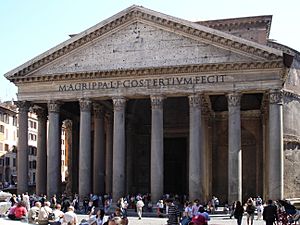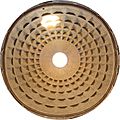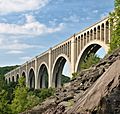Concrete facts for kids
Concrete is a super important material used to build many different buildings and structures. Think of it like a special mix, or "composite," made from Portland cement, sand, gravel (also called "aggregate"), and water. The amounts of each ingredient can change depending on what the concrete will be used for.
Concrete is actually the most used man-made material in the world! Back in 2006, people made about 7.5 billion cubic meters of concrete every year. That's more than one cubic meter for every person on Earth!
To make concrete, all the ingredients are mixed together to form a thick paste, a bit like making dough for bread. This wet concrete is then poured into a special frame or mold. After just a few hours, it starts to get hard. Concrete becomes solid because of a chemical reaction with the water, called "hydration." The water and cement work together to glue all the other parts, like sand and gravel, into a strong, stone-like material.
Concrete is used for so many things! You can find it in pavements, pipes, cool architectural structures, building foundations, motorways, bridges, multi-story parking garages, walls, and even the bases for gates, fences, and poles. Some people even build boats out of it! One of its biggest strengths is how well it sticks together bricks and stones, better than almost anything else we know.
Concrete is very strong when you push on it (this is called "compression"). But it's not very strong if you try to pull it apart (this is called "tension"). So, for some buildings and structures, steel rods are added inside the concrete to make it stronger when pulled. This is called Reinforced concrete. Buildings made with reinforced concrete can connect all their parts – the foundations, walls, floors, and roofs. However, concrete buildings are not automatically safe from earthquakes.
Concrete has been around for a very long time, since about 5600 BC! The Romans didn't invent it, but they used it a lot. They even discovered types of concrete that were waterproof and some that could set even underwater!
How Concrete Is Improved
People have found many ways to add things to concrete to make it better. These extra ingredients are called "additives." They can make concrete set faster or slower, become stronger, or help prevent rust.
The Romans learned that adding volcanic ash made a concrete that could set underwater. They also found that adding horse hair helped stop concrete from cracking as it dried. And believe it or not, adding animal blood made it more resistant to frost!
Modern concrete, as we know it, was first made in 1756 by a British engineer named John Smeaton. He added pebbles and powdered brick to his cement mix. Then, in 1824, an English inventor named Joseph Aspdin created Portland cement. This is still the main type of cement used today. He made it by burning ground-up limestone and clay together. This burning process changed the materials chemically, making a much stronger cement than just crushed limestone.
The 1800s brought another big invention: reinforced concrete. A French gardener named Joseph Monier came up with the idea in 1849 (and got a patent for it in 1867). This is concrete with steel bars inside it, often called rebars (short for reinforcing bars). Today, sometimes glass fiber or plastic fiber is used instead of steel bars.
Many modern chemicals can be added to concrete mixes for special reasons. "Superplasticizers" are chemicals that make concrete easier to work with and shape before it sets. Pigments can be added to change the usual dull grey color. Corrosion inhibitors help stop the steel bars inside from rusting. "Air entrainment" means blowing tiny bubbles into the concrete before it sets. This helps the concrete survive cold climates where it might freeze and thaw. Even Blast furnace slag can be mixed in; it makes the concrete almost pure white and even stronger.
Images for kids
-
A vast concrete structure - The Hoover Dam.
-
Opus caementicium exposed in a characteristic Roman arch. Roman concrete was usually covered with brick or stone.
-
Boston City Hall (1968) is a Brutalist design built mostly with precast and poured concrete.
-
The City Court Building in Buffalo, New York.
-
Aerial photo of reconstruction at Taum Sauk (Missouri) pumped storage facility in late November 2009. The new reservoir was made of roller-compacted concrete.
-
Stylized cacti decorate a sound/retaining wall in Scottsdale, Arizona.
-
Pohjolatalo, an office building made of concrete in the city center of Kouvola in Kymenlaakso, Finland.
-
The Tunkhannock Viaduct in northeastern Pennsylvania opened in 1915 and is still used regularly today.
See also
 In Spanish: Concreto para niños
In Spanish: Concreto para niños





























